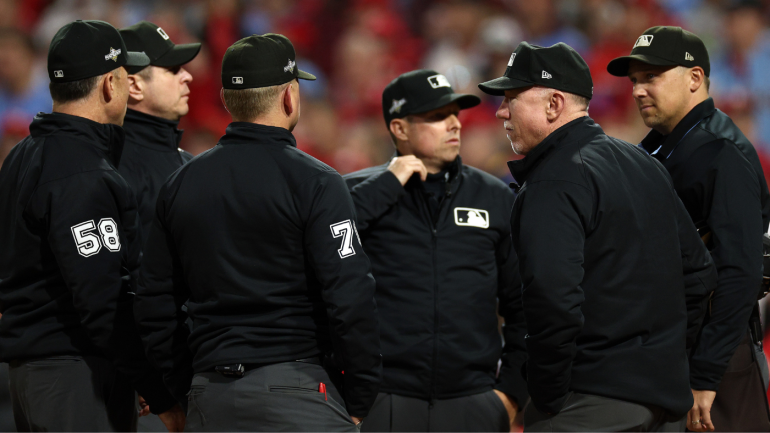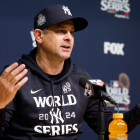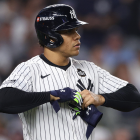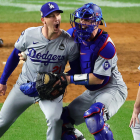
Welcome to Snyder's Soapbox! Here I pontificate about a matter related to Major League Baseball on a weekly basis. Some of the topics will be pressing matters, some might seem insignificant in the grand scheme of things and most will be somewhere in between. The good thing about this website is it's free and you are allowed to click away. If you stay, you'll get smarter, though, that's a money-back guarantee. Let's get to it.
This iteration of the ol' Soapbox comes with a twist. I've had a rant stored up for years, but I went seeking answers from an authority on the matter to see if I could be set straight. We'll start with the rant.
For years, I've wondered why in the world are the outfield umpires in the playoffs positioned so close to their infield brethren. It seemed to me that the whole purpose of adding fifth and sixth umpires to the crew for the postseason was to better cover the outfield, which means stuff that is out of eye shot from the infield umpires. Let's say there's a possible basket catch against the wall, fan interference either far down the line or over the outfield wall and, of course, home run/foul ball calls around the foul pole.
If that's the case, shouldn't the outfield umpires be far down the line, even on the warning track or up against the wall?
Instead, here's where they stand.
I remain baffled at the OF umpire positioning. They should be back by the warning track so they don't miss foul ball/HR calls pic.twitter.com/jHcedrik4y
— Matt Snyder (@MattSnyderCBS) October 31, 2023
Regarding the foul pole calls, it seemed to me that it should be officiated like umpires under the goal post in football to see if a kick is good or no good. Just look straight up and watch for where the ball crosses. Plus, if there's another Jeffrey Maier incident, the umpire is right there:
With the outfield umpires being so close to the infield, it just looks totally unnecessary and redundant. Why even have the fifth and sixth game officials if their view is hardly different than two of the others?
I got in touch with Mike Everitt, a former umpire who is now an umpire supervisor for Major League Baseball. He's tasked with overseeing four crews all season. Here are some of the things he told me about the positioning.
"In the umpire's manual we have a section on mechanics for a six-umpire system," Everitt explained. "What we all have to realize is that during the season we're working a four-umpire system. A six-umpire system is not natural, it's not common. You feel like a fish out of water when you get out there, especially for the first time as a major-league umpire working postseason. There's no specific 'X marks the spot' that we tell our umpires to get behind the third-base or first-base umpire. It's kind of what you feel comfortable with because you have multiple responsibilities out there.
"The first thing you have to make sure of is you don't want to get in the way of -- say for instance I'm the right-field umpire behind first base. Any fly ball that is bringing the right fielder and the second baseman and the first baseman converging in your area, any time you feel pressure, you get outta there. You just get out of the way so you're not in the way of the fielder and that puts all the onus on the first-base umpire."
Regarding my biggest complaint, that umpires should be under the foul pole in order to best judge the home run vs. foul ball plays, here's what Everitt had to say:
"As far as the distance, I can see how people would think the closer you are, the better, but I would like to give you an example of some of the things we discuss as you start progressing as an umpire. It's like looking at a picture. The closer you get, the more limited you get. In order to get the full picture, sometimes I gotta back off a little bit. On the fair/foul, on the pole, sometimes the first- and third-base umpires might get a better look. And, actually, the second-base umpire if it's slicing or hooking, they could have a better look as well because they can see the ball disappear behind the pole or go in front of the pole. It's all about the angle or depth perception of what you're looking at.
"You definitely don't want to be, as a right-field or left-field umpire, too close. Right off the bat, you're trying to follow the ball. At a certain point, you lose that ball sometimes if it's inside, but then you're just honing in on the pole. You get a sense if it's going to be close and then you're honing in on that pole to see the ball cross on the left or the right or over the top of it. If you're too close to that pole, you have no shot of that."
I should also clarify that my football/goal post example isn't very good, and during the course of my conversation with Everitt I realized as much. A football is much larger than a baseball and isn't traveling nearly as fast as a baseball flying by a foul pole. It's entirely plausible that an umpire directly under the foul pole wouldn't be able to spot the tiny speck of a baseball from that vantage point.
There are, of course, other considerations on lining up.
"It depends on the stadium as well, how far the lines are and how deep, so you're positioning yourself anywhere between 15 and 20 feet behind that first-or-third-base umpire," Everitt added.
"As far as the catch/no-catches, all we're doing there is putting two more sets of eyes on it. For instance, if there are no runners on and there's a deep fly out to center field and the second-base umpire goes out, we're still moving our umpires out there to have two more sets of eyes on that.
"Now, with runners on, if the second-base umpire is in the middle, then the catch/no-catch responsibilities go to the left-and-right-field umpires. For instance: Runners on first and second, second-base umpire in the middle, deep fly ball to center field. Usually what we try to do is make really good eye contact if there's a possible catch/no-catch situation so we could have a double call. That would be for a diving play."
So, was I set straight?
Honestly, I still think they could stand to have a little bit more distance down the lines, but I've never umpired a game above Little League, which means I'm not qualified to decide that. Plus, I was definitely wrong about being up against the wall or even on the warning track. Everitt convinced me of that. And, obviously, if there is a mistake such as on this play ...
... replay is there to clean it up.
Adjusting to 'mentally exhausting' pitch clock
Here's some more on Major League Baseball umpires, who are, in my opinion, the best officials among the major sports. It's a view I hold strongly. They are generally pretty amazing at getting the bang-bang calls right, especially ones that we think are wrong when viewed with the naked eye. Replay has helped get us closer to the likely-unattainable 100% threshold on officiating calls, but this isn't all too far off.
There are always going to be complaints about balls and strikes, and I'll once again state that I believe MLB umpires are remarkable, generally, at calling them. If you disagree, feel free to take up the task of better assembling a group of people who can judge the zone when an orb is flying 95+ miles per hour with movement.
On top of all that, umpires in recent years have have a bunch of responsibilities added to their plates. In addition to dealing with how to conduct replay reviews, they've also been given the duty of pitcher spot checks and, this past season, the pitch clock.
In our interview, Everitt noted that it was initially quite the adjustment.
"A lot of us were a little tentative about it because of the added responsibilities to the umpires," he said. "I'm so happy that we got it going. We had a lot of meetings to speak with the teams and we went full sprint into it in spring training and alleviated a lot of misgivings about it in trying to see how it was gonna work. I always tell everyone, change is hard."
Part of the adjustment is that change from a routine is always difficult, but also because a lot of the natural breaks provided by baseball in the past were now gone.
"It was mentally exhausting," Everitt added. "Not only are you trying to get every pitch correct, now you're in charge of making sure the batter is alert and ready and looking at the pitcher in eight seconds. You have another electronic device on you that buzzes on the zero for the pitcher. You have multiple rules on stepping out of the box, stepping in the box, disengagements, and what happened at first was the two hour and 30 minute games, it felt like 3:15 to the umpires because they didn't have a break.
"They didn't have a break between pitches, they didn't have a break between innings. It was go time."
Just as the players, fans and media alike adjusted to new-look Major League Baseball, the men in blue adjusted as well.
"As the season continued, like everything, with repetition, it got manageable," Everitt said. "Each person, each crew learned how to manage with it in different ways, giving different responsibilities to different umpires. At the end of the day, when you're walking off the field 15 to 20-30 minutes earlier in the long haul, it was great."
"And it was good for the game," he remarked with excitement. "We said we weren't gonna change in the playoffs and we didn't. We were consistent and even the postseason game times went down.
"I think our staff has done a great job with it and they're excited to keep moving on."

















